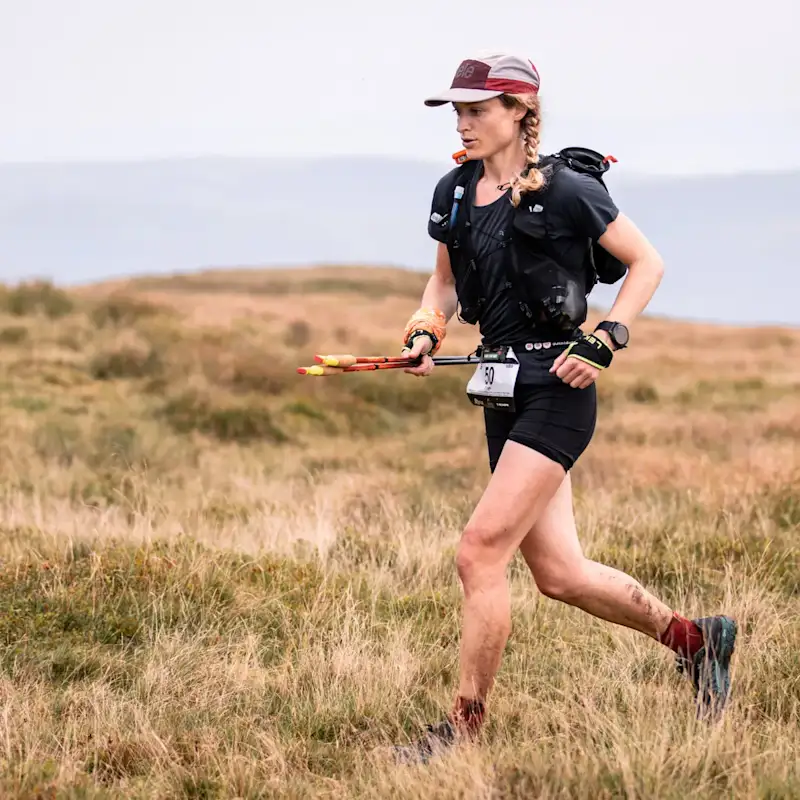
Robyn Cassidy
Helvellyn Sky Ultra
Robyn's headline numbers
Robyn's strategy
Fueling
Carbohydrate is the main fuel you burn when racing. Failing to fuel properly is a leading cause of underperformance in longer races.
Robyn’s carbohydrate intake predominantly came from PF Carb & Electrolyte Drink Mix and approximately 1-2 gels per hour. She also incorporated a pack of PF 30 Chews and half an energy bar she picked up on course, which helped her get extra fuel on board and avoid flavour fatigue. Even though this race wasn’t as long as some of the other races we see athletes undertaking, avoiding flavour fatigue is crucial to be able to consume consistent and high amounts of carbs for an extended period of time. Robyn started with an effective strategy by fueling 30 minutes into the race, instead of waiting until 60 minutes in as she had previously. She had planned to fuel every 30 minutes but lost track of this towards the second half of the race, mainly due to some GI issues. Robyn should continue to train her gut to increase her tolerance of hitting 60g/h+ for longer durations, especially in preparation for her multi-day ultra coming up.
Hydration
Taking on board an appropriate amount of fluid and sodium is essential to maintaining blood volume and supporting the cardiovascular effort needed to perform on race day.
Whilst the absolute amount of sodium and fluid consumed per hour is important, it’s critical to consider these in relation to each other. This is known as 'relative sodium concentration' and it’s expressed in milligrams per litre (mg/L). How much sodium you’re taking in per litre of fluid is more important than the absolute amount taken in per hour.
For the first time before a race, Robyn followed a preloading protocol by drinking 500ml of PH 1500 both the night before and morning of the race. As a result, she reported feeling “really hydrated at the start”! Although we don’t know Robyn’s exact sweat losses over the race, from her subjective feedback, post-race headache and dark pee colour, it was likely she undershot her fluid intake. Early on in the race her only source of fluid was PF Carb & Electrolyte Drink Mix, which provided more carb than she has taken on previously. Furthermore, taking in this much carb-rich liquid early on can cause it to rush to the gut and overwhelm the intestines’ capacity to absorb, which could be the culprit for the discomfort and bloating she reported. Robyn could reserve one of her bottles for just hydration, for example containing PH 1000, in an attempt to avoid these issues and allow her to drink more fluid over the race. Going forward, collecting sweat rate data and getting a Sweat Test will help Robyn dial in her hydration strategy even more.
Caffeine
Beyond the Three Levers of Performance (carb, sodium and fluid), caffeine is one of only a few substances that is proven to improve performance for most endurance athletes as it can help stave off mental and physical fatigue.
Given Robyn only had a coffee pre-race and the fact that caffeine has a half life of ~4-5 hours, she may have benefited from periodically replenishing the levels of caffeine in her blood in an attempt to retain the performance enhancing benefits that the stimulant provides.
How Robyn hit her numbers
Here's everything that Robyn ate and drank on the day...
Robyn's weapons of choice
Final thoughts
Robyn's full stats
Data Confidence?
There is an adequate level of accuracy in the data collected and the numbers reported. The athlete manages to recall what they ate and drank including most specifics (brands flavours quantities plausible estimations of volumes). However there are estimations made within the data which affect the overall confidence level in the data reported.